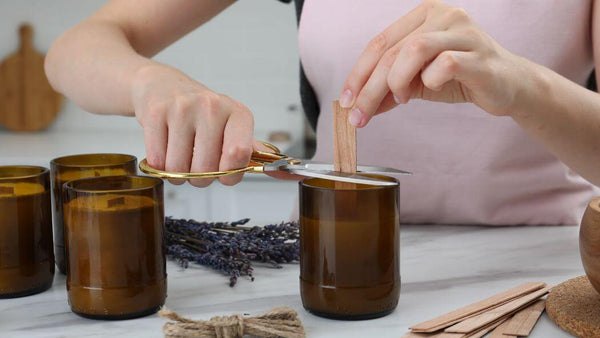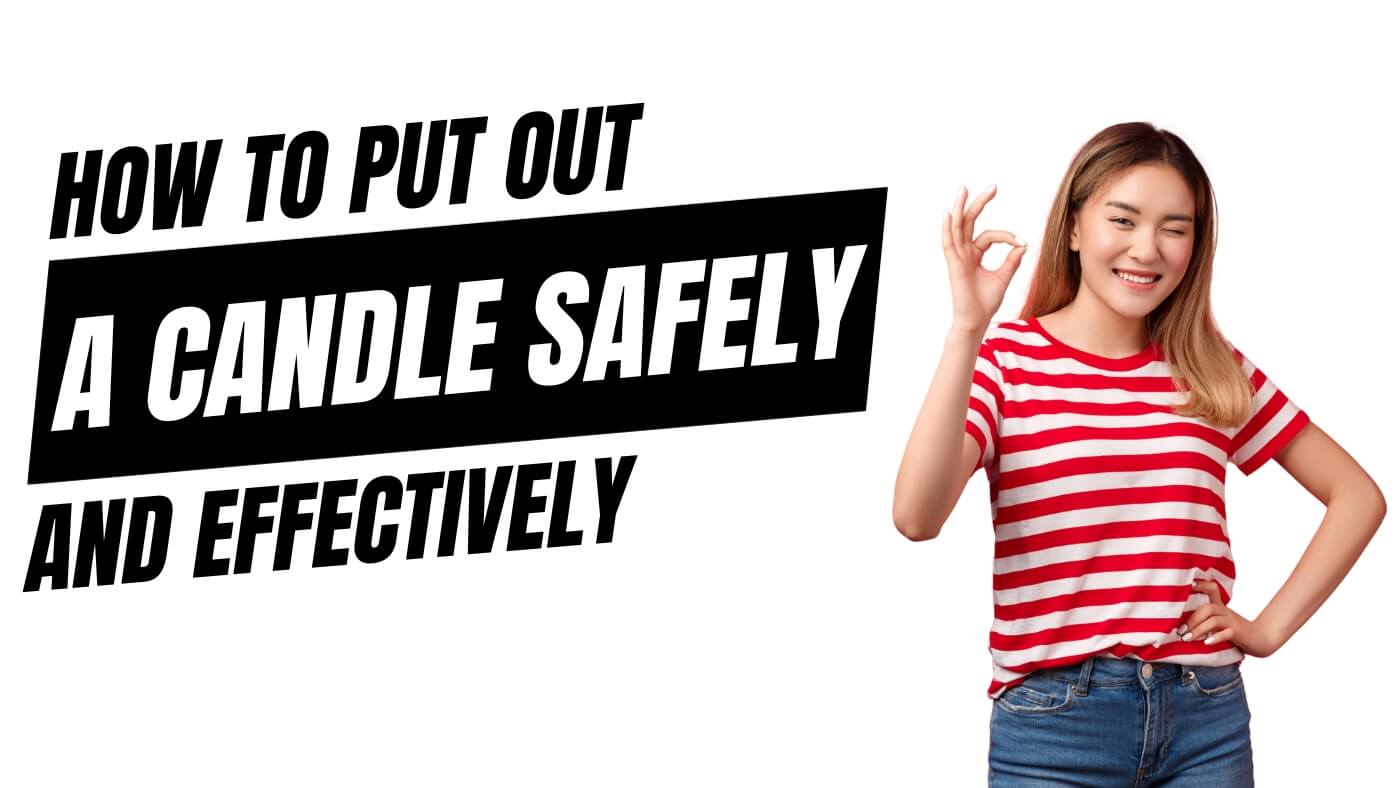Have you ever been captivated by the soft, warm glow of a candle, only to be assaulted by a cloud of smoke when it's time to extinguish it? Or perhaps you've experienced the small panic that comes with a stubbornly flickering flame that refuses to go out. Extinguishing candles seems like a straightforward task, but doing it improperly can lead to smoke, wax splatters, or even potential fire hazards.
This article is your comprehensive guide on 'How to Put Out a Candle Safely and Effectively.' We'll explore the various methods you can use, common mistakes to avoid, and essential safety measures to ensure your candle experience remains a delightful one.
So, let's illuminate the subject and snuff out any concerns you may have!
The Importance of Safely Extinguishing Candles
Candles are more than just a source of light; they bring warmth and ambiance to our homes, serve as mood enhancers, and often play a vital role in our relaxation routines. However, their benefits can quickly turn into hazards if we don't handle them with care, especially when it comes to extinguishing them. The process of safely putting out a candle involves more than merely snuffing out the flame. It's about minimizing smoke, preventing wax splatter, and most importantly, reducing the risk of accidental fires.
By learning how to extinguish candles properly, you're not only preserving the life of your candle but also ensuring the safety of your home.
Common Mistakes to Avoid When You Extinguish a Candle
Even though extinguishing a candle might seem like a simple task, there are common mistakes many people make that could lead to unnecessary risks or damage to the candle. Here are some to be aware of:
Blowing Out Candles: While this is the most common method, blowing out a candle can cause hot wax to splatter, potentially burning your skin or damaging nearby objects. Moreover, it often results in a large plume of smoke, which can leave an unpleasant smell and even set off smoke alarms.

Using Water to Douse the Flame: Pouring water on a candle might seem like a good idea, but it can actually cause the hot wax to spurt out, creating a mess and potentially causing burns. Furthermore, water can cause glass candle holders to crack due to the sudden change in temperature.

Not Trimming the Wick Before Lighting: If you don’t trim the wick to about 1/4 inch before you light the candle, it can cause the flame to become too large and produce excess smoke when extinguished.

In the following sections, we'll delve into the correct techniques and tools to use when extinguishing your candles, ensuring a safe and pleasant experience every time you light one up.
The Best Ways to Put Out a Candle
There are several effective and safe ways to extinguish a candle. Let's explore some of the most common methods and learn how to use them properly.
Using a Wick Dipper (For Cotton Type Wicks)
Recommended:
A wick dipper is a simple but ingenious tool that allows you to put out a candle without any smoke or wax splatter.
How a Wick Dipper Works
The wick dipper works by bending the wick into the wax pool to extinguish the flame. Here's how it's done:
-
Hold the wick dipper at an angle, with the curved end near the flame.
-
Gently push the wick into the wax pool until the flame is put out.
-
Once the flame is extinguished, use the wick dipper to straighten the wick, preparing it for the next use.
This method not only prevents smoke but also coats the wick with wax, making it easier to light the next time.
The Candle Snuffer Method
Recommended:
A candle snuffer is another popular tool used to safely extinguish candles. It's especially useful for candles in deep containers or lanterns where you can't easily reach the wick.

Correct Usage of a Candle Snuffer
Using a candle snuffer is straightforward:
-
Slowly lower the snuffer over the flame until it's fully enclosed.
-
Hold the snuffer over the flame for a few seconds to ensure it's completely extinguished.
-
Remove the snuffer carefully to avoid disturbing the wax pool.
The Lid Technique
Some people like to use the lid to put out their candle. While it works it is not the preferred way.
Steps to Use the Lid Technique
Here's how to use the lid technique:
-
Slowly place the lid over the candle jar, leaving a small gap for the heat to escape.
-
Once the flame has died down, close the lid completely.
This method suffocates the flame, reducing smoke and preserving your candle's fragrance.
The Pinch and Release Method
Some people like to do use this method, however we do not recommend it as it requires caution to avoid burns.
How to Properly Execute the Pinch and Release Method
Here's how to do it (although we recommend you don't):
-
Wet your fingers with water to protect them from the heat.
-
Quickly pinch the wick between your fingers and immediately release.
-
Be careful not to touch the wax, as it can be hot.
The Blowing Out Method
Like the previous two options this is not the most recommended (unless it's candles on a birthday cake, then it's the #1 method). Blowing out a candle is still widely used, however, it's important to ensure safety when using this method.

Ensuring Safety with the Blowing Out Method
To safely blow out a candle:
-
Keep your face a safe distance from the candle to avoid hot wax splatters.
-
Blow gently to put out the flame without disturbing the wax pool too much.
By understanding and employing these methods, you can ensure a safe and pleasant candle experience every time.
Dealing with Potential Issues When You Extinguish A Candle
While candles bring a sense of warmth and tranquility, they can also present challenges that require careful handling. Two common issues faced by candle enthusiasts are wax splatters and the misconception of using water to extinguish candle flames.
How to Handle Wax Splatters
Wax splatters can occur when you blow out a candle or when the wick is too long. Not only can this make a mess, but it can also be dangerous as hot wax can cause burns.

Here's how to handle wax splatters:
Prevention: Trim the wick to about 1/4 inch before you light the candle. This helps control the size of the flame and reduce the chances of wax splattering.
Clean up: If wax does splatter, let it cool and harden. For wax spills on a wood surface, use a dull knife or credit card to scrape off as much wax as you can. For wax spills on fabric, place a paper towel over the wax and iron on a low heat setting. The heat from the iron will melt the wax, and the paper towel will absorb it.
Safety: If hot wax splatters on your skin, immediately run cold water over the area to cool it down and prevent further damage. Seek medical attention if the burn is severe.
Why Water Isn't Recommended for Candle Extinguishing
Pouring water into a candle to put out the flame might seem like a logical step, but it's actually a bad idea for several reasons:
Splattering Wax: Water can cause the hot wax to splatter, potentially leading to burns or a mess to clean up.
Cracking Glass Holders: If your candle is in a glass holder, the sudden temperature change from the water can cause the glass to crack or shatter.
Inefficiency: Water can create a barrier between the wick and the wax, making it harder to relight the candle later.
The safest and most effective ways to put out a candle involve using a wick dipper, or snuffer.
In Conclusion
Candles are a wonderful way to enhance the ambiance of your home, providing a warm glow and often a delightful fragrance. However, it's crucial to remember that they also present certain risks and challenges.
By understanding the proper methods to extinguish a candle, handling potential issues like wax splatters, knowing why water isn't recommended for putting out candles, and adhering to fire safety measures, you can ensure a safe and enjoyable candle-lighting experience.
Always remember, safety should be your top priority when using candles or any open flames. With the right precautions and knowledge, you can enjoy the serene beauty of candles while keeping your home safe.
If this article was helpful, you might want to take a peak at our "Candle Lovers Ultimate Guide to Scented Candles". You can find it by clicking here.


